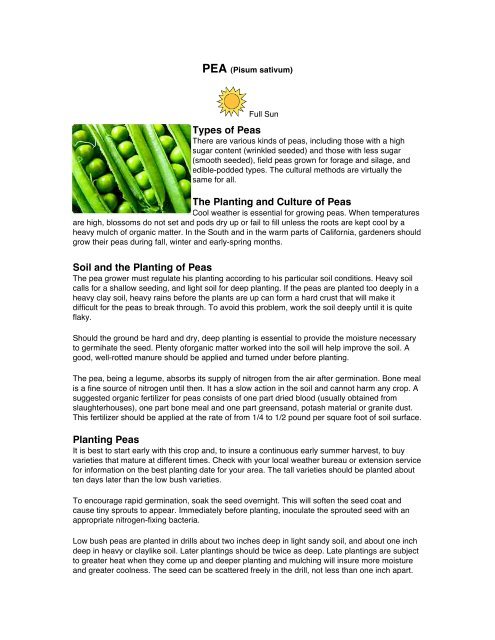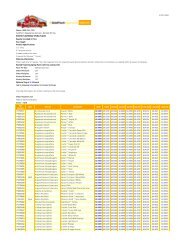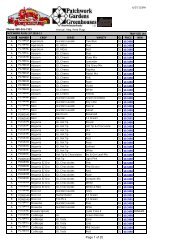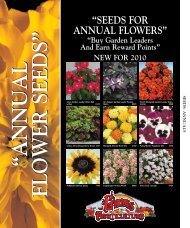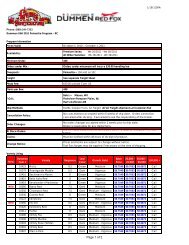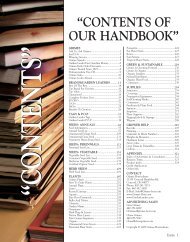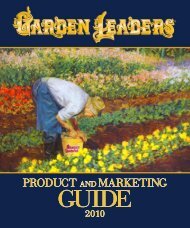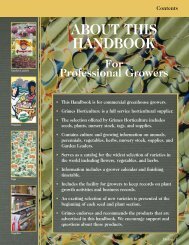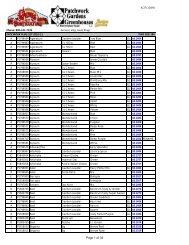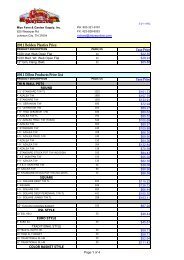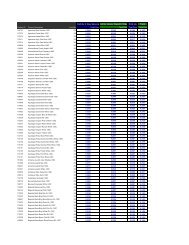Types of Peas The Planting and Culture of Peas Soil and the ...
Types of Peas The Planting and Culture of Peas Soil and the ...
Types of Peas The Planting and Culture of Peas Soil and the ...
You also want an ePaper? Increase the reach of your titles
YUMPU automatically turns print PDFs into web optimized ePapers that Google loves.
PEA (Pisum sativum)<br />
Full Sun<br />
<strong>Types</strong> <strong>of</strong> <strong>Peas</strong><br />
<strong>The</strong>re are various kinds <strong>of</strong> peas, including those with a high<br />
sugar content (wrinkled seeded) <strong>and</strong> those with less sugar<br />
(smooth seeded), field peas grown for forage <strong>and</strong> silage, <strong>and</strong><br />
edible-podded types. <strong>The</strong> cultural methods are virtually <strong>the</strong><br />
same for all.<br />
<strong>The</strong> <strong>Planting</strong> <strong>and</strong> <strong>Culture</strong> <strong>of</strong> <strong>Peas</strong><br />
Cool wea<strong>the</strong>r is essential for growing peas. When temperatures<br />
are high, blossoms do not set <strong>and</strong> pods dry up or fail to fill unless <strong>the</strong> roots are kept cool by a<br />
heavy mulch <strong>of</strong> organic matter. In <strong>the</strong> South <strong>and</strong> in <strong>the</strong> warm parts <strong>of</strong> California, gardeners should<br />
grow <strong>the</strong>ir peas during fall, winter <strong>and</strong> early-spring months.<br />
<strong>Soil</strong> <strong>and</strong> <strong>the</strong> <strong>Planting</strong> <strong>of</strong> <strong>Peas</strong><br />
<strong>The</strong> pea grower must regulate his planting according to his particular soil conditions. Heavy soil<br />
calls for a shallow seeding, <strong>and</strong> light soil for deep planting. If <strong>the</strong> peas are planted too deeply in a<br />
heavy clay soil, heavy rains before <strong>the</strong> plants are up can form a hard crust that will make it<br />
difficult for <strong>the</strong> peas to break through. To avoid this problem, work <strong>the</strong> soil deeply until it is quite<br />
flaky.<br />
Should <strong>the</strong> ground be hard <strong>and</strong> dry, deep planting is essential to provide <strong>the</strong> moisture necessary<br />
to germihate <strong>the</strong> seed. Plenty <strong>of</strong>organic matter worked into <strong>the</strong> soil will help improve <strong>the</strong> soil. A<br />
good, well-rotted manure should be applied <strong>and</strong> turned under before planting.<br />
<strong>The</strong> pea, being a legume, absorbs its supply <strong>of</strong> nitrogen from <strong>the</strong> air after germination. Bone meal<br />
is a fine source <strong>of</strong> nitrogen until <strong>the</strong>n. It has a slow action in <strong>the</strong> soil <strong>and</strong> cannot harm any crop. A<br />
suggested organic fertilizer for peas consists <strong>of</strong> one part dried blood (usually obtained from<br />
slaughterhouses), one part bone meal <strong>and</strong> one part greens<strong>and</strong>, potash material or granite dust.<br />
This fertilizer should be applied at <strong>the</strong> rate <strong>of</strong> from 1/4 to 1/2 pound per square foot <strong>of</strong> soil surface.<br />
<strong>Planting</strong> <strong>Peas</strong><br />
It is best to start early with this crop <strong>and</strong>, to insure a continuous early summer harvest, to buy<br />
varieties that mature at different times. Check with your local wea<strong>the</strong>r bureau or extension service<br />
for information on <strong>the</strong> best planting date for your area. <strong>The</strong> tall varieties should be planted about<br />
ten days later than <strong>the</strong> low bush varieties.<br />
To encourage rapid germination, soak <strong>the</strong> seed overnight. This will s<strong>of</strong>ten <strong>the</strong> seed coat <strong>and</strong><br />
cause tiny sprouts to appear. Immediately before planting, inoculate <strong>the</strong> sprouted seed with an<br />
appropriate nitrogen-fixing bacteria.<br />
Low bush peas are planted in drills about two inches deep in light s<strong>and</strong>y soil, <strong>and</strong> about one inch<br />
deep in heavy or claylike soil. Later plantings should be twice as deep. Late plantings are subject<br />
to greater heat when <strong>the</strong>y come up <strong>and</strong> deeper planting <strong>and</strong> mulching will insure more moisture<br />
<strong>and</strong> greater coolness. <strong>The</strong> seed can be scattered freely in <strong>the</strong> drill, not less than one inch apart.
As <strong>the</strong> plants come up <strong>the</strong>y can be thinned to st<strong>and</strong> two to three inches apart. One pound <strong>of</strong> seed<br />
is enough for a 100-foot row.<br />
High varieties are planted somewhat differently. <strong>The</strong> seed are planted in double rows 30 to 36<br />
inches apart. <strong>The</strong> rows can consist <strong>of</strong> two parallel drills six inches apart, or one trench six inches<br />
wide <strong>and</strong> four inches deep. Plant seed about 21/2 inches apart <strong>and</strong> cover <strong>the</strong>m with enough soil<br />
to half-fill <strong>the</strong> drills or trench. After <strong>the</strong> plants have emerged, finish filling-in <strong>the</strong> rows. Planted in<br />
this way, about one pound <strong>of</strong> seed will plant a double, 100-foot row.<br />
Supporting Pea Plants<br />
No variety <strong>of</strong> peas will amount to much without <strong>the</strong> proper support for <strong>the</strong> plants. <strong>The</strong> best ones<br />
are made <strong>of</strong> brush that has plenty <strong>of</strong> twigs <strong>and</strong> has its bark intact. Placed firmly in <strong>the</strong> ground<br />
between <strong>the</strong> rows, this "brush fence" should st<strong>and</strong> about four or five feet high.<br />
Many gardeners prefer to use a fine-mesh chicken-wire fence instead <strong>of</strong> <strong>the</strong> brush since it may be<br />
used season after season. Wire should be securely fastened to stakes placed at six-foot intervals<br />
down <strong>the</strong> rows. Small-meshed wire is best because it sags less than <strong>the</strong> larger-meshed kind.<br />
Pea Insect Pests <strong>and</strong> Diseases<br />
<strong>The</strong>re are a few common diseases <strong>of</strong> peas. <strong>The</strong>ir severity is usually determined by climatic<br />
conditions. Fungi which cause root rot may destroy <strong>the</strong> entire pea crop. A good control is to rotate<br />
<strong>the</strong> crop with unrelated crops each season. Do not plant peas on low-lying spots where drainage<br />
is poor. <strong>The</strong> same measures are valuable in controlling wilt, bacterial blight <strong>and</strong> anthracnose. If<br />
you are having trouble with damping-<strong>of</strong>f, you may be planting your peas too deeply.<br />
Many kinds <strong>of</strong> insects may attack peas, but only two are serious pests. <strong>The</strong> pea aphid attacks<br />
young vines <strong>and</strong> sucks <strong>the</strong> juices from <strong>the</strong> developing tips. <strong>The</strong> pea weevil infests <strong>the</strong> pods.<br />
Harvesting <strong>Peas</strong><br />
Green peas should be harvested when <strong>the</strong>y are young <strong>and</strong> tender. If left to hang on <strong>the</strong> vines too<br />
long, <strong>the</strong>y become starchy <strong>and</strong> hard. <strong>The</strong>y should be shelled <strong>and</strong> cooked within an hour or so<br />
after picking because in two hours after picking <strong>the</strong> sugar begins to turn to starch. Although still<br />
edible, <strong>the</strong>y are not as sweet.<br />
Tearing or jerking pods from <strong>the</strong> vines injures <strong>the</strong> plants so much that <strong>the</strong>y may stop bearing<br />
pods. Since peas mature rapidly, plan to preserve <strong>the</strong> surplus by canning, or preferably, freezing.<br />
<strong>Peas</strong> can also be dried. Shell <strong>and</strong> blanch for 15 minutes over steam. Dry in <strong>the</strong> sun or use<br />
ano<strong>the</strong>r method <strong>of</strong> drying.<br />
Edible-pod varieties should be harvested when <strong>the</strong> peas are just beginning to form. At this stage,<br />
<strong>the</strong> pea <strong>and</strong> <strong>the</strong> pod are stringless <strong>and</strong> can be eaten toge<strong>the</strong>r. <strong>Peas</strong> alone can be eaten at a later<br />
stage, but <strong>the</strong>y must be picked while still young.<br />
Varieties <strong>of</strong> <strong>Peas</strong><br />
A number <strong>of</strong> pea varieties are available. <strong>The</strong> familiar green peas come in extra-early, dwarf <strong>and</strong><br />
large varieties. Extra Early Alaska is <strong>the</strong> earliest dwarf available; it is hardy, wilt resistant <strong>and</strong><br />
matures uniformly.<br />
Improved Laxton's Progress is an early dwarf that grows to about 16 to 18 inches high <strong>and</strong>
produces large pods <strong>of</strong> uniform size.<br />
Little Marvel holds <strong>the</strong> peas in picking condition longer than o<strong>the</strong>r varieties. Burpee's Blue<br />
Bantam produces well over a long period if <strong>the</strong> pods are kept picked. Lincoln, which reaches 30<br />
inches in height, is a good freezer that produces through July. W<strong>and</strong>o, a good main-crop pea,<br />
st<strong>and</strong>s hot, dry wea<strong>the</strong>r well, <strong>and</strong> is a good canner <strong>and</strong> freezer.<br />
Edible-pod peas are also called snow peas <strong>and</strong> sugar peas. <strong>The</strong>y are eaten pod <strong>and</strong> all <strong>and</strong> can<br />
be used raw in salads, steamed or stir-fried with Chinese foods. Melting Sugar is a tall-st<strong>and</strong>ing<br />
variety, producing four- to five-foot vines that must be staked. Dwarf Gray Sugar is an early,<br />
hardy <strong>and</strong> disease-resistant dwarf.<br />
O<strong>the</strong>r types <strong>of</strong> edible peas are brown Crowder peas, available in several varieties, <strong>and</strong> blackeyed<br />
peas. <strong>The</strong> latter can be eaten fresh or dried for later use.


